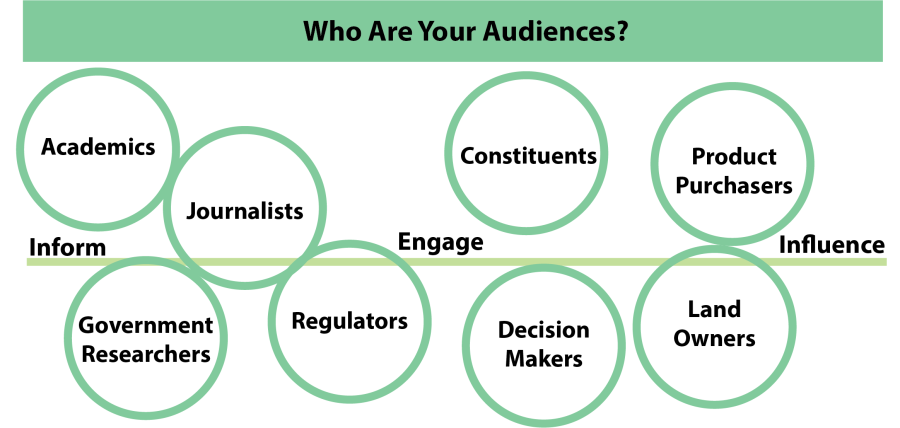Who Are Your Audiences?

Audiences for your research are building blocks for bridging knowledge to actionable science. To develop a strong communication strategy and determine a multi-faceted approach, you will need to understand with whom you wish to communicate. Keep in mind:
- Many audiences will be interested in your research.
- Each will require different approaches to engage them effectively. The form of communication that works with one audience might flop with another.
- It is important to recognize and understand the different perspectives of each audience and how they might engage with your research.
Doing an Audience-Centered Analysis
An audience-centered analysis can help you think about the perspectives and motivations of each unique audience so that you can adapt communication products (for example, written commentary, speech, or graphic) to their interests, level of understanding, attitudes, and beliefs.
The following list of questions (also linked below in an editable format) will help you better understand each unique audience and inform appropriate methods of communication that serve the needs of your audience(s). (Consider revisiting this analysis throughout your research process as your agenda shifts in focus and scope or as you identify new audiences or goals.)
Step 1: Brainstorm Potential Audiences & Their Unique Characteristics:
Brainstorm many unique audiences. Approach this step with careful consideration. Try to avoid “general public” and, instead, focus on a narrow audience to understand their biases and values.
- First, write down broad categories or groups of people, e.g., other researchers, policymakers, community members, etc., with whom your research may be relevant.
- Next, try to be more specific within each category—are there certain institutions or faculty who would benefit from your research? Are particular policymakers relevant to the decision-making surrounding your topic of interest? Are there any communities that you could partner with as you develop your research questions or that would benefit from your findings?
- Then, list what you believe to be some of the values, motivational forces, and/or needs of each group and how your research intersects with some of these entities.
- Do any groups need to make decisions that could be informed by your research?
- Finally, rank each group by relevance to your research and write them in descending order in the boxes provided on the worksheet.
Step 2: Consider Your Relationship with The Audiences:
- What is your relationship to each audience?
- How much credibility do you have with the audience?
- What are the sources of that credibility? E.g., Your position within an organization? Your technical expertise? Your track record? Your relationship with key people? Your personal characteristics? Your shared values with the audience?
- How can you increase or reinforce your credibility with the audience?
- Who are other relevant influencers of the audience(s)? How do they connect to your audience and what do they know? How do they portray different issues? How might these outside groups react to your messages?
- Does the audience have any biases about the subject?
- Are there any political factors that need to be taken into account?
Step 3: Determine your audience-centered goals.
- What does the audience already know about the subject? How are they involved in the matter?
- What’s in it for the audience? Are you solving a problem? Are you raising awareness?
- What is the objective of the communication—to inform, engage, or influence? Or some combination of those?
- What is the desired response from this audience? Are they simply taking in information? Do you wish to collaborate? Are you looking to change their behavior? What would you like them to do as a response to your communication?
- If your goal is to inform, what key points do you wish to share?
- If you wish to collaborate, why might that be useful to them?
- If you wish to change or influence their behavior, what information revealed in your research may sway them to do that?
- What questions or objections might the audience have?
Continue to the next step of the toolkit: How to Reach Your Audience.